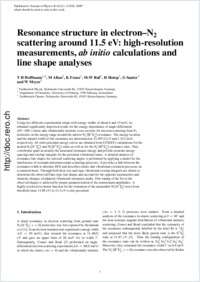Resonance structure in electron–N₂ scattering around 11.5 eV: high-resolution measurements, ab initio calculations and line shape analyses
- Hoffmann, T. H. Fachbereich Physik, Technische Universität, Kaiserslautern, Germany - Department of Chemistry, University of Fribourg, Switzerland
- Allan, Michael Department of Chemistry, University of Fribourg, Switzerland
- Franz, K. Fachbereich Physik, Technische Universität, Kaiserslautern, Germany
- Ruf, M.-W. Fachbereich Physik, Technische Universität, Kaiserslautern, Germany
- Hotop, Hartmut Fachbereich Physik, Technische Universität, Kaiserslautern, Germany
- Sauter, G. Fachbereich Chemie, Technische Universität, Kaiserslautern, Germany
- Meyer, W. Fachbereich Chemie, Technische Universität, Kaiserslautern, Germany
-
2009
Published in:
- Journal of Physics B. - 2009, vol. 42, no. 21, p. 215202
English
Using two different experimental setups with energy widths of about 6 and 13 meV, we obtained significantly improved results for the energy dependence of angle-differential (10°–180°) elastic and vibrationally inelastic cross sections for electron scattering from N₂ molecules in the energy range around the narrow N⁻₂(R²Σ⁺g) resonance. The energy location and the natural width of this resonance are determined as 11.497(2) eV and 1.3(2) meV, respectively. Ab initio potential energy curves are obtained from CCSD(T) calculations for the neutral N₂(X¹Σ⁺g) and N*₂(E³Σ⁺g) states as well as for the N⁻₂(R²Σ⁺g) resonance state. They corroborate quite accurately the measured resonance energy and provide accurate energy spacings and overlap integrals for the pertinent vibrational states. A detailed analysis of resonance line shapes for selected scattering angles is performed by applying a model for the interference of resonant and nonresonant scattering processes. It provides a link between the resonance width to absolute DCS and describes elastic and vibrational excitation processes on a common basis. Through both their size and sign, vibrational overlap integrals are shown to determine the observed Fano-type line shapes and account for the opposite asymmetries and intensity changes of adjacent vibrational resonance peaks. Fine-tuning of the fits to the observed shapes is achieved by proper parametrization of the nonresonant amplitudes. A highly resolved excitation function for the formation of the metastable N*₂(E³Σ⁺g) level from threshold (near 11.88 eV) to 13.4 eV is also presented.
- Faculty
- Faculté des sciences et de médecine
- Department
- Département de Chimie
- Language
-
- English
- Classification
- Chemistry
- License
-
License undefined
- Identifiers
-
- RERO DOC 12946
- DOI 10.1088/0953-4075/42/21/215202
- Persistent URL
- https://folia.unifr.ch/unifr/documents/301364
Statistics
Document views: 138
File downloads:
- pdf: 210
